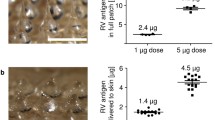Abstract
Available information concerning mucosal immune response to naturally-acquired or vaccine-induced viral infections is largely limited to the development of antibody responses. Limited information exists concerning the appearance and role of virus-specific mucosal T cell-mediated immune responses after oral or systemic immunization in humans. In general, naturally acquired infections, or immunizations by replicating vaccine viruses administered by the mucosal routes which mimic the route of natural infection are associated with the development of effective immune responses in the serum as well as secretory sites, and exhibit protection against mucosal reinfection and development of disease (Piedra and Ogra 1986). In view of the large surface area of the intestinal mucosa and the presence of greater mass of gut-associated lymphoid tissue (GALT), in comparison to the content of lymphoid tissue in the respiratory tract, genital tissue and other mucosal sites, it has been proposed that oral immunization may result in the development of higher magnitude of immune response in the respiratory and other mucosal sites than after immunization by the systemic routes or after direct immunization of other mucosal sites (Mestecky 1987). Recent studies carried out to examine this possibility are briefly summarized here.
Access this chapter
Tax calculation will be finalised at checkout
Purchases are for personal use only
Preview
Unable to display preview. Download preview PDF.
Similar content being viewed by others
References
Ada GL, Leung K-N, Ertie H (1981) An analysis of effector T cell generation and function in mice exposed to influenza A or Sendai viruses. Immunol Rev 58:5–24
Andrew ME, Coupar BEH, Boyle DB, Ada GL (1987) The roles of influenza virus haemagglutinin and nucleoprotein in protection: Analysis using vaccinia virus recombinants. Scand J Immunol 25:21–28
Baba K, Yabuuchi H, Takahashi M, Ogra PL (1982) Immunologic and epidemiologic aspects of varicella infection acquired during infancy and early childhood. J Pediatr 100:881
Bastin J, Rothbard J, Davey J, Jones I, Townsend A (1987) Use of synthetic peptides of influenza nucleoprotein to define epitopes recognized by class I-restricted cytotoxic T lymphocytes. J Exp Med 165:1508–1523
Bogger-Goren S, Baba K, Hurley P, Yabuuchi H, Takahashi M, Ogra PL (1982) Antibody response to varicella-zoster virus following natural or vaccine-induced infection. J Infect Dis 146:260–265
Bogger-Goren S, Bernstein JM, Gershon AA, Ogra PL (1984) Mucosal cell-mediated immunity to varicella zoster virus: Role in protection against disease. J Pediatr 105:195–199
Fishaut M, Murphy D, Neifert M, Mcintosh K, Ogra PL (1981) Bronchomammary axis in the immune response to respiratory syncytial virus. J Pediat 99:186–191
Gotch F. Rothbard J, Howland K, Townsend A, McMichael A (1987) Cytotoxic T lymphocytes recognize a fragment of influenza virus matrix protein in association with HLA-A2. Nature 326:881–882
Mestecky J (1987) The common mucosal immune system and current strategies for induction of immune responses in external secretions. J Clin Immunol 7:265–276
Ogra PL, Karzon DT (1971) Formation and function of poliovirus antibody in different tissues. Progr Med Virol 13:156–193
Ogra PL, Fishaut M, Welliver RC (1980) Mucosal immunity and immune response to respiratory viruses. In: Weinstein L, Fields B (eds) Seminars in Infectious Diseases, Vol III. Thieme-Stratton New York, p 225
Ogra PL, Losonsky GA, Fishaut M (1983) Colostrum-derived immunity and maternal-neonatal interaction. Ann NY Acad Sci 409:81–95
Ogra PL (1984) Mucosal immune response to poliovaccines in childhood. Rev Infect Dis 6:S361–S368
Piedra PA, Ogra PL (1986) Immunologic aspects of surface infections in the lung. J Pediatr 108:817–823
Salk D (1980a) Eradication of poliomyelitis in the United States. I. Live virus vaccine-associated and wild poliovirus disease. Rev Infect Dis 2:228–242
Salk D (1980b) Eradication of poliomyelitis in the United States. II. Experience with killed poliovirus vaccine. Rev Infect Dis 2:243–257
Salk D (1980c) Eradication of poliomyelitis in the United States. III. Poliovaccines-practical considerations. Rev Infect Dis 2:258–273
Welliver RC, Kaul A, Ogra PL (1979) Cell-mediated immune responses to respiratory syncytial virus infection: Relationship to the development of reactive airway disease. J Pediatr 94:370–375
Yamada A, Ziese MR, Young JF, Yamada YK, Ennis FA (1985) Influenza virus hemagglutinin-specific cytotoxic T cell response induced by polypeptide produced in Escherichia coli. J Exp Med 162:663–674
Zhaori G, Sun M, Ogra PL (in press) Characteristics of immune response to poliovirus virion polypeptides after immunization with live or inactivated polio vaccines. J Infect Dis
Author information
Authors and Affiliations
Editor information
Editors and Affiliations
Rights and permissions
Copyright information
© 1989 Springer-Verlag Berlin · Heidelberg
About this paper
Cite this paper
Ogra, P.L., Leibovitz, E.E., Zhao-Ri, G. (1989). Oral Immunization and Secretory Immunity to Viruses. In: Mestecky, J., McGhee, J.R. (eds) New Strategies for Oral Immunization. Current Topics in Microbiology and Immunology, vol 146. Springer, Berlin, Heidelberg. https://doi.org/10.1007/978-3-642-74529-4_8
Download citation
DOI: https://doi.org/10.1007/978-3-642-74529-4_8
Publisher Name: Springer, Berlin, Heidelberg
Print ISBN: 978-3-642-74531-7
Online ISBN: 978-3-642-74529-4
eBook Packages: Springer Book Archive




